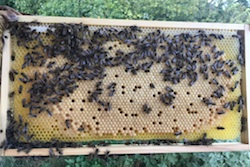Heat treatment protects honey bees from crippling virus
Bee populations across Europe are in trouble but Austrian researchers have found a way of reducing the viral load in honey bee colonies which is efficient and totally free of chemicals. Researchers from engineering consultancy ECODESIGN company used funding from the HApi project to assess how well an existing product, the Varroa Controller, performs in protecting honey bees from the Deformed Wing Virus or DWV. Managed bees populations seem to be declining in Europe although scientists do not always agree on how fast or why. The tiny red-brown Varroa mite, which attacks honey bee larvae inside the cell, is a major contributor. But this parasite also acts as a carrier for a growing army of viruses, such as DWV, a pathogen which can leave young bees crippled and unable to fly. The combination of the two can be lethal for honey bee colonies. “The Varroa mite being present is one thing, but the situation is getting really dangerous because the mite is a highly effective vector transmitting viruses by directly injecting virus particles into the unborn bee’s hemolymph,” says Adriana Díaz, HApi project co-ordinator and senior researcher at ECODESIGN. For treatment involves placing up to 20 frames containing the capped bee brood inside the Varroa Controller. This is then heated to a controlled temperature by warm, humidified air for two hours. They reach “a temperature that damages the Varroa mite significantly,” says Wolfgang Wimmer, ECODESIGN managing director. He explains treatment is based on the principle that bees tolerate higher temperatures than the Varroa mite, a fact discovered by German academic Wolf Engels in the 1980s. Applying hyperthermia in this way kills 97 % of the Varroa mites, according to tests by the Bavarian Bee Institute in January 2017, and while the HApi team are not yet ready to publish the data on its effect on DWV, the results are promising. Early break-out Field observations of beekeepers using the Varroa Controller and Ecodesign’s own tests show a secondary, key effect: the heat treatment seems to accelerate the break-out of DWV in young bees at clinical and significant sub-clinical viral levels, by placing the larva under a small amount of stress. Other bees detect these infected bees and expel them from the hive. The benefits of this are manifold. Removing this diseased cohort not only has an immediate cleansing effect but is preventative too as it stops the virus being passed on to future generations. “Usually the first task of a newborn bee is to nurse the next generation, in which case it transmits the virus through feeding, and so it goes on,” says Dr Díaz. Under HApi, the team has examined the local regulatory and patent requirements for introducing the Varroa Controller as a way of combatting DWV in honey bees in seven European countries and is preparing for commercial launch. They plan to apply for SME funding to assess other impacts of the earlier break-out of the virus on hives and to find the best time of year for a combined heat treatment, as well as quantifying the extent of the cleansing effect. Much is at stake. Recent data from the European Commission shows Austrian beekeepers are losing on average 30 % of their hives a year. “The unofficial numbers are much higher,” says Dr Díaz, “during HApi phase 1 we interviewed beekeepers in Slovakia who were losing more than 50 %.”
Keywords
HApi, apiculture, honey bees, hyperthermia, heat treatment, Deformed Wing Virus, Varroa mite, bee health



